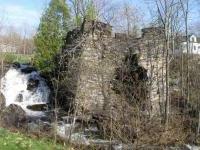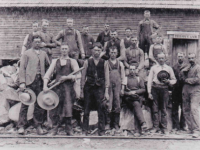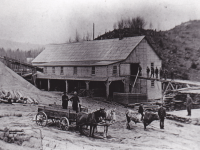 The Mills during the period of the French, British and Eastern Townships
The Mills during the period of the French, British and Eastern Townships
Under the French Regime, the territory was divided into seigneuries (the seigneurial system of New France) and each Seigneur (landowner) was obligated to construct and operate a mill for the use of the tenants. The Seigneur was also responsible for road construction and maintenance. The mills at the time were wind powered and mainly used to grind grain. The mills were built in a cylindrical form on a high parcel of land in order to capture the wind. And the technology and know-how came from France.
Under the British regime, anyone was permitted to build and operate a mill. In the Eastern Townships, land was granted according to the British Township Model based on individual ownership (freehold land tenure). This was the case in the Township of Bolton.
All the mills constructed in the Townships were water powered. They were built in the shape of a cube with a sloping roof and were constructed in steep areas along a water source with strong currents to capture the maximum water power.
Since most of the Townships’ early settlers came from New England, the first mills applied the technology that was common in New England. In fact, this “know how” originally came from Great Britain. Over time the technology evolved and turbine mills were constructed which used the force of the water to turn the mill shaft. The turbine technology is still used today in the hydro electric stations.
 In the Eastern Townships, the main types of mills were:
In the Eastern Townships, the main types of mills were:
- grinding mills (flour)
- saw mills
- carding mills
- fulling mills.
All four types of mills were found in the Township of Bolton. There was even a smithy or forge that used water power.
The First Mills in the Township of Bolton
The Township of Bolton was founded in 1797 by Leader Nicholas Austin and his 53 Associates. It was the largest of the Eastern Townships. At its beginning, Bolton spread from the Sutton Mountains to the western shore of Lake Memphremagog and Magog River. Austin had decided to settle in the South west sector of the township by Gibraltar Point. Most of his Associates also settled in that area which is the region known today as the Municipality of Austin.
Around 1793 or 1794, Nicholas Austin operated a small portable mill along a creek near his residence at Gibraltar Point. Pioneers used the mill, which ran day and night. However the early settlers preferred to use a real mill built by one of the 53 Associates, Alexander Thompson. The mill was built before 1799.
For several years, Alexander Thomson’s mill would be the main mill of the Township of Bolton and of the surrounding townships. It is said that people came from as far away as Stukely (about 23 kilometers distant) to have their various grains and cereals milled. Thompson selected a location for the mill on the Powell Brook, which empties into Lake Memphremagog at Sargent’s Bay. Thomson’s mill soon became a center of activities and its area was named Thompson’s Mills.
Other mills were built along the Powell Brook. The two archaeologists (member of Archéotec) have researched over a number of years the history of many of the mills of that brook and inspected some of their remains.
Decline of the first mills, rise and boost in East Bolton
An important feature emphasized is that the mills did not remain isolated settings. They became a central point of attraction in the area and roads were quickly built to bring commerce to the mill. Often a store would also be built near by. As the community developed and grew around the mill, a school, church and post office were constructed.
 In fact, a large number of Villages that exist today, started next to a mill. In the Municipality of East Bolton, it was the case for the Villages of South Bolton and Bolton Centre along the Missisquoi River. Similar to the Thompson’s Mills, at their beginnings, those two sites were known as Holland’s Mills and Willard’s Mills.
In fact, a large number of Villages that exist today, started next to a mill. In the Municipality of East Bolton, it was the case for the Villages of South Bolton and Bolton Centre along the Missisquoi River. Similar to the Thompson’s Mills, at their beginnings, those two sites were known as Holland’s Mills and Willard’s Mills.
The mills of Powell Brook eventually lost their importance in the Township and in the area. They declined and closed one-by-one. They were partly replaced by the mills of the Missisquoi River, which were located in more accessible and busier areas.
Above all, while the Powell Brook dries up often during summers, the flow of the Missisquoi River is more regular and more substantial; that allowed its mills to process larger amounts of grain, wood and wool.